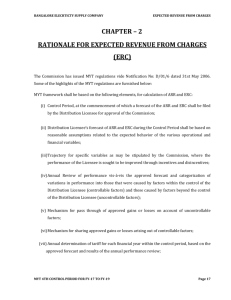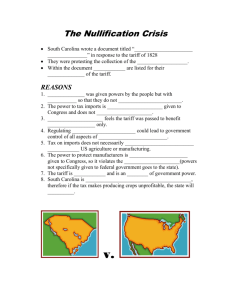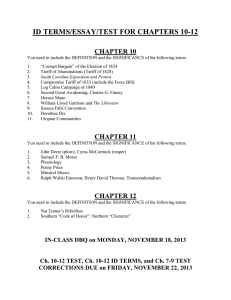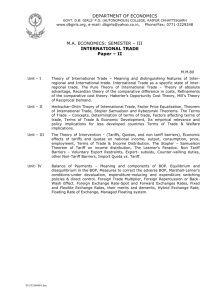Discussion paper on Draft Tariff Policy
advertisement
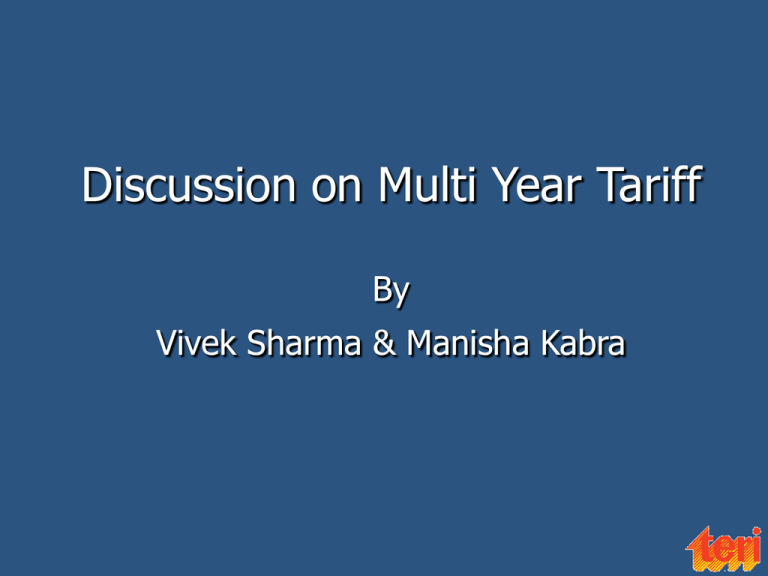
Discussion on Multi Year Tariff By Vivek Sharma & Manisha Kabra Structure MYT – The Concept Rationale for MYT Benefit of MYT Enabling Environment Draft tariff policy Experience in South Asia Issues in Implementation MYT – The Concept “ a new system where the tariff setting exercise is done for a number of years in one exercise, termed as MYT” Concept of MYT can mean several things ranging from: Prescribing the actual numbers Adherence to certain specific benchmarks that will prevail for a number of years. It can also govern the principles governing the input costs and output prices at two different ends. Rationale for MYT The present system of annual determination is too flexible giving considerable freedom to arbitrary decision making. Average time taken: 3-6 months It is an answer to make the tariff setting exercise more predictable. To ensure that costs are recovered in a more mechanistic manner. Benefits of MYT Reduction in regulatory effort on the part of the commissions , utilities. Reduction in regulatory uncertainty Provision of a transparent and stable system of incentives. Will lead to greater private sector interest in investment in the power sector. Enabling Environment Pakistan Privatisation Commission Government guidelines to NEPRA India The Electricity Regulatory Commission Act, 1998 The Electricity Act 2003 (61 f) Draft tariff policy India- Draft tariff policy: Broad principles of tariff setting To mitigate the risk related to data uncertainity, State Commissions: Use AT&C losses Ensure 100% metering SERC to design incentive/disincentive for this SERC should lay down a methodology for estimation of agricultural consumption Initiate action for verification of system losses including agricultural consumption, Base year operating expenses, Capital expenditure plan Cont. Mitigation of risks related to regulatory uncertainty SERC to decide time frame for implementing price-cap regulation SERC to determine (Control period = 3-5 years) Principles of risk sharing (between the utility and the consumers Definition of controllable and uncontrollable expenses for the utility Parameters and principles for incentives/ disincentives Opening levels of key parameters Customer service standards to be met by the utility Experience in South Asia India Pakistan Most commissions experimented with multi-year targets related to T&D losses & collection efficiency Uttar Pradesh Incentivising framework adopted . In 2000-01 UPPCL proposed reduction in T&D losses from 36.5% to 17.5% over the next decade Losses decreased marginally; from 41.55% to 41.4%. Multi-year path laid down previously by UPERC had to be revised Maharashtra- Loss sharing Implicit adoption of MYT - targets indicated in Tariff Order of 2000 Against mandated loss reduction to 26.89%, losses were reduced to only 39.4%. MERC held consumers equally responsible for losses - cost of excess losses to be borne equally by MSEB and consumers Delhi Delhi Vidyut Board proposed long-term principles for tariff determination in 2001-02 DERC -sector was not mature for the introduction of MYT Government notification - MYT incorporated in privatisation process Bidding criteria: reduction in loss levels Negotiated losses were accepted Incentivising framework of multi-year tariffs Only one discom were unable to achieve targets Pakistan - Karachi Supported by Govt. of Pakistan - Reasons included privatization NEPRA approved MYT in Sept. 2002 NEPRA considered price-cap as an appropriate way of maximizing incentives • Allowed a price capped multi year tariff with adjustments for inflation, Fuel price, power purchase. Cont. • • • • Indexation (CPI - X) allowed on annual basis. Fuel and power purchase adjustment allowed quarterly. Sliding scale profit sharing mechanism. No loss sharing. Price control period is 7 years Issues in implementation of MYT Availability of reliable information: Regulatory process cannot wait for perfect information, which given its external position, it can never obtain. However, reliable and timely information is an imperative, and all steps should be taken to achieve this. Sharing of downward and upward targets Controllable and non-controllable costs Cont. Government Subsidy Phased out our the period of time. What should be the Control period? Needs preparedness and involvement of all participants. Thank You
